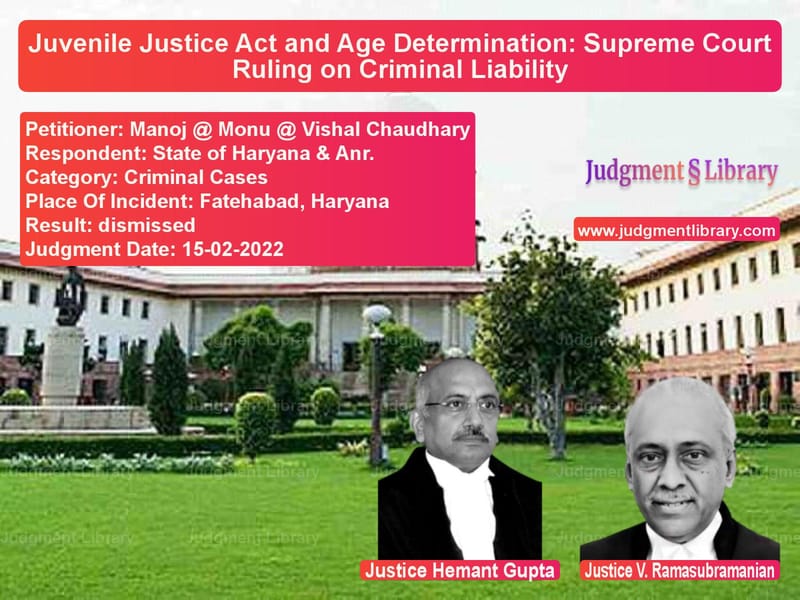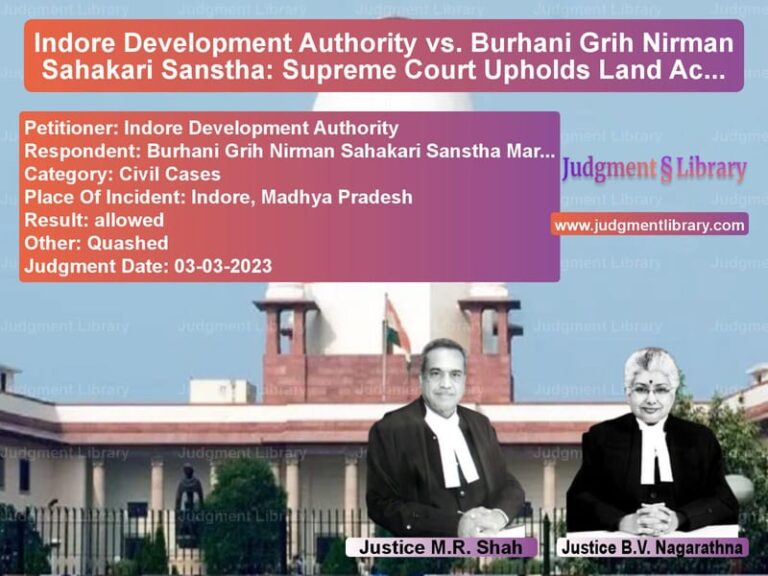Juvenile Justice Act and Age Determination: Supreme Court Ruling on Criminal Liability
The case of Manoj @ Monu @ Vishal Chaudhary vs. State of Haryana & Anr. is a crucial judgment concerning the determination of juvenility in criminal cases. The Supreme Court had to decide whether the appellant, accused of a serious crime, should be tried as a juvenile or an adult based on conflicting age records.
The appellant was accused of robbery and murder in an incident that occurred on 18th January 2011. During the trial, he claimed to be a juvenile at the time of the offense, relying on his school records. However, medical tests and other documents suggested otherwise. The case went through multiple legal stages, including the Additional Sessions Judge, the High Court of Punjab and Haryana, and finally, the Supreme Court.
Background of the Case
The appellant was charged with intercepting a car and robbing Rs. 22 lakhs from its occupants. During the robbery, one of the victims, Bhim Singh, was shot and killed. As the trial progressed, the appellant moved an application in 2014, claiming juvenility and presenting a school certificate stating his date of birth as 13th May 1993. If accepted, this would mean he was below 18 years old at the time of the offense.
The Additional Sessions Judge accepted his claim and declared him a juvenile. However, the High Court, upon revision, set aside this order, citing evidence that contradicted his claim. The appellant was then ordered to stand trial as an adult, which led to the appeal before the Supreme Court.
Legal Dispute Over Age Determination
The Juvenile Justice (Care and Protection of Children) Act provides specific guidelines for determining the age of an accused in cases of juvenility claims. According to Rule 12(3) of the Juvenile Justice Rules, 2007, the priority of documents for determining age is:
- Matriculation or equivalent certificate
- Birth certificate from the first attended school
- Birth certificate issued by a municipal authority or panchayat
- Medical examination in the absence of the above documents
In this case, the appellant’s birth certificate was issued only in 2014, after his application for juvenility, raising doubts about its credibility. The school leaving certificate was also contested, as there were discrepancies in the institution’s records. Lastly, the medical board’s ossification test estimated his age to be between 23-24 years, suggesting he was an adult at the time of the crime.
Arguments Before the Supreme Court
Appellant’s Arguments
The appellant’s counsel contended that:
- The school records confirmed his date of birth as 13th May 1993, making him a juvenile at the time of the offense.
- The benefit of the doubt should be given to the accused under the Juvenile Justice Act, which is a beneficial legislation.
- Even the ossification test, which estimated his age at 23-24 years in 2016, had a margin of error of two years.
State’s Arguments
The prosecution argued:
- The birth certificate was issued long after the crime and appeared to be manipulated.
- The school leaving certificate was unreliable due to inconsistencies in the school’s existence and registration.
- The family register, which had an official record of birth, showed a different date than what was claimed.
- The medical board’s ossification test conclusively proved that the appellant was above 18 at the time of the crime.
Supreme Court’s Judgment
The Supreme Court upheld the High Court’s decision, rejecting the appellant’s claim of juvenility. The Court noted:
“The appellant has approached the Court with unclean hands as the documents relied upon by him are not genuine and trustworthy. The birth certificate was issued only after the juvenility claim, the school records were unreliable, and the medical report suggested he was an adult. Thus, he cannot be given the benefit of juvenility.”
The Court emphasized that while the Juvenile Justice Act is a welfare legislation, it cannot be used to shield an accused who fabricates documents. It observed:
“The medical report determining the age of a person has never been considered conclusive in nature. However, when documentary evidence is unreliable, medical evidence gains significance. In this case, the medical opinion aligns with other available evidence indicating that the appellant was not a juvenile.”
Key Observations from the Judgment
- The birth certificate and school records were unreliable and appeared to be created for legal benefit.
- The family register, maintained under official rules, held evidentiary value and contradicted the appellant’s claims.
- The ossification test suggested that the accused was well above 18 years at the time of the crime.
- The Court ruled that beneficial legislation cannot be misused to fabricate juvenility claims.
Conclusion
This ruling sets an important precedent on how courts should evaluate claims of juvenility, especially when documents appear fabricated. The Supreme Court’s emphasis on verifying documentary evidence before granting the benefit of the Juvenile Justice Act ensures that the law is not exploited by accused individuals seeking to evade harsher punishment.
The judgment reinforces that while juveniles must be given protections under the law, those who manipulate documents to claim juvenility cannot misuse the system to avoid justice.
Petitioner Name: Manoj @ Monu @ Vishal Chaudhary.Respondent Name: State of Haryana & Anr..Judgment By: Justice Hemant Gupta, Justice V. Ramasubramanian.Place Of Incident: Fatehabad, Haryana.Judgment Date: 15-02-2022.
Don’t miss out on the full details! Download the complete judgment in PDF format below and gain valuable insights instantly!
Download Judgment: manoj-@-monu-@-visha-vs-state-of-haryana-&-a-supreme-court-of-india-judgment-dated-15-02-2022.pdf
Directly Download Judgment: Directly download this Judgment
See all petitions in Juvenile Justice
See all petitions in Judgment by Hemant Gupta
See all petitions in Judgment by V. Ramasubramanian
See all petitions in dismissed
See all petitions in supreme court of India judgments February 2022
See all petitions in 2022 judgments
See all posts in Criminal Cases Category
See all allowed petitions in Criminal Cases Category
See all Dismissed petitions in Criminal Cases Category
See all partially allowed petitions in Criminal Cases Category







